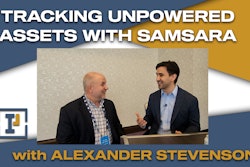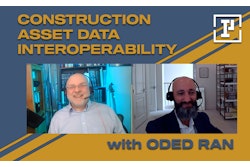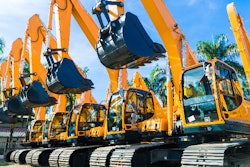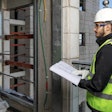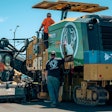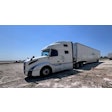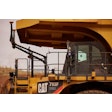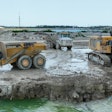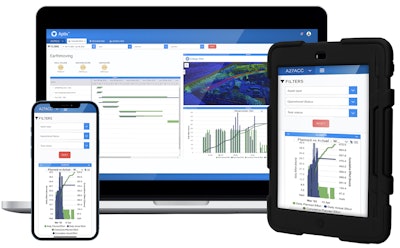
Internet of Things (IoT) devices used for construction equipment tracking and machine control tend to be proprietary to a technology company or software product, but Topcon’s new integration platform as a service (iPaaS) offering aims to bridge that gap on job sites.
Aptix automates and orchestrates the distribution of data, including machine control files, constructible models, project schedules, and reports on actuals. It shows, in near real-time, the location of machines with the ability to aggregate as-built data from mixed fleet telematics. Aptix can then deliver real-time reports on people, materials, machines, and carbon dioxide emissions, creating greater visibility for carbon footprint and sustainability initiatives.
The Aptix platform will not be anything to all people—there are according to Topcon Global Director, Business Development and Marketing, Integration Services Scott Langbein no plans to extend the solution to takeoffs, for instance. In a September 2023 discovery call, Langbein said the focus was on capturing data from takeoff tools in products from partners including Autodesk, HCSS, or AgTek. The initial focus according to Langbein has been on 3D machine control. Starting with 3D machine control makes sense because contractors may be running equipment with multiple machine control systems from various manufacturers, each with their proprietary software.
“We connect most heavy equipment, so excavators, motor graders, dozers, scrapers,” Langbein said. “For the most part, these types of equipment have several options in themselves as to what GPS control or total station machine control technology they have access to. So we have a tier of all heavy equipment that is machine controlled. And then the next tier down is heavy equipment that is only telematics controlled. And the telematics, we like to simplify that and track just location on and off, and that—that’s just telematics. But over and above that, Topcon’s sweet spot is really the machine control where you're controlling the blade, and you're automating the blade to the model. You're telling the operator to follow the task based on the schedule.”
Apart from capturing data from and relaying models to the machine, Aptix can tie execution into the field into the project schedule.
“The schedule has the task, the task has the model, the machine has the hydraulic control, and the operator is performing in line with the plan—that is the top tier,” Langbein said. “But with telematics the numbers are a lot higher. There's a ton of equipment out there, and we can even go into trucks. So you're going to be tracking data from yards, concrete plants, asphalt plants and more.”
Compact Equipment and Attachment Automation
Aptix is not just focused on heavy iron—it is encompassing data flows with more and more compact machines and attachments.
“The trend has been towards compact machine control,” Langbein said. “So the smaller Bobcats, you know, TCOs, (compact track loaders), machines that run around on a little track, one guy driving a little bucket. The industry's made a number of attachments for these devices—drag boxes for grading, backhoe arms, different solar power pile drivers and things. We're also pursuing that because those have machine control or telematics as well. And that's where the numbers are. John Deere, Komatsu, Topcon and Trimble and like, everybody is pursuing that space with those compact machine controls.”
There will be a shaking out, Langbein said, between open technologies like Aptix that communicate with this far-flung assortment of machines and solutions from original equipment manufacturers (OEMs).
Proprietary barriers are falling between other business applications, including enterprise resource planning (ERP) and other back-office tools as application programming interfaces (APIs) enable what Gartner called the Composable Enterprise of integrated but separate software products underpinning business processes.
“There are some technical hurdles that we just need to negotiate and work through as a partner,” Langbein said.
Horn in on our conversation with Scott Langbein for a quick overview of Topcon Aptix.
Machine Control Integration
Aptix leverages AEMP standard telematics data and the Topcon Tierra telematics solution.
“That's pretty that's I would say that's on the easier side of things,” Langbein said. “The question you mentioned about true interoperability with machine control, the separate proprietary playgrounds are still there. There's the Trimble playground and the Topcon playground and there are still proprietary walls up around some of the systems. It will stay that way until the until the clientele say ‘I need to be able to exchange data between all these machines.’
Langbein likened the current situation with machine control to a similar point in the development of RTK (real-time kinematic positioning) radios used by base stations and rovers.
“Each playground—Topcon, Trimble, John Deere—they all pick their own radio protocols,” Langbein said. “And it got to be really crazy because a contractor couldn't connect one machine to another or one base to another machine because of the radio program.”
Langbein said Topcon is participating in talks with the International Standards Organization to identify a machine control data standard. ISO/TS 15143-4 is one section of a developmental earth-moving machinery and mobile road construction machinery standard dealing specifically with topographical data.
“Let's get that topography data in a standard that all of us can use, no matter what the machine type or the machine control sensor type is,” Langbein said.
The current state of affairs is clearly suboptimal because when a contractor is running equipment with grade control or machine control technology from more than one vendor, the equipment complement on a site or project cannot be managed together due to the proprietary barriers. Aptix and other applications can access data from a telematics unit or off the CAN bus, but not systems that automate the end effector of the piece of equipment.
“If a customer has five Trimble machine control systems and five Topcon machine control systems on this project, my dashboards will only show the Topcon blade location, machine control data and as-built data,” Langbein said. “My system will show the on time and off time and location on and off along with telematics data of all the machines, even if it's a Trimble system, but I can't see their equipment. And it's vice versa, too.”
New Product for Topcon
Aptix marks Topcon’s entry into the integration platform category. The groundwork for the product was laid between 2020 and 2022 during a joint venture between Topcon and Digital Construction Works. During this partnership, Digital Construction Works built the web framework that would become Aptix.
“What we intended to do on that joint venture was to be a services provider to construction companies, to help them make their own digital twin of their activities and their construction projects,” Lanbein, who came into Topcon from Digital Construction Works, said. “We needed to build this platform as our delivery mechanism for the digital twin. It has a map component, a schedule component and a reporting component, all net new built over that timeframe. And the thing that changed was, when the joint venture ended after three years, Topcon acquired the technology and the people, and we are productizing it into more of a packaged solution. So it's no longer a services provider mission—we now have a product that our customers can use to better understand their digital reality and digital construction projects.”
Topcon acquired Digital Construction Works in March of 2023 to harness data from connected devices and equipment not just to provide an as-built at the end of the project or phase, but to provide contractors a real-time view of actuals versus plan.
"DCW enables the connection of the job site and the office," Former Digital Construction Works CEO, now Vice President and General Manager of Digital Construction Works at Topcon, Jason Hallet said in a release at the time of the acquisition. "Automation and the availability of integrated and aggregated data provide greater insights into project performance and status. Now, as part of Topcon, our integrations platform enhances the value of Topcon’s interoperability with third-party software typically used to execute machine-guided operations. This saves users time and money by automating report generation and eliminating manual data entry across a multi-vendor and multi-stakeholder project environment."
Standardization Versus Harmonization
A number of construction applications ranging from analytics to asset management currently on the market rely not on standards but on their own capabilities to clean, scrub and harmonize data from different sources to create a unified data source across proprietary boundaries. This also potentially has a place in the Aptix solution, according to Langbein.
“That’s what we have to do with every product,” Langbein said. “Every data source, whether it's the schedule, the model, or proprietary data, safety data—they have to be able to read that data structure and build the data mapping tables to get it into our database structure … but then you have to have that data validation layer because you're always going to have a certain amount of data that's you expect to come in but it doesn't come in or match up. It's kind of like the BIM space when asset names don't match.”
Aptix has its own database structure that captures data from connected systems and devices for analysis and transactional execution.
Current Aptix Functionality
As Topcon and other industry players pursue standardization of topographical data, the Aptix product can still drive value to contractors by helping them reporting their actuals and track progress by comparing machine performance to planned performance. The software can also track location of equipment and other telematics-related data points, presenting them in a usable interface tied to the project.
“What customers say now is that “I need to know how many feet of pipe did my guys lay today?’” Langbein said. “’And I need to know that without driving out there.’ We'll track the machine, whenever the machines operate and how far they dug.”
This solves the problem of unreliable or inconsistent reporting from the field—sometime commonly experienced since site workers are probably not hired for administrative and reporting skills.
Aptix Pricing and Market
Topcon’s Aptix application is priced based on a number of variables including the machines themselves, data collection hardware requirements and the OEM family families of telematics involved.
Capturing machine control data would require additional custom work. Machine control data could be involved with due diligence on the type of control system, including whether it is GPS, laser or total station controlled and the OEM family of products. Topcon’s Blend Plus telematics tool encompasses this data in a single application with a unified data structure across mixed fleets.
Contractors and other fleet owners running mid-sized to large mixed fleets of heavy or light equipment may want to look at Aptix as a way to eliminate inefficiencies in the field and in the office.
BOTTOM LINE: From Equipmentshare T3 to Tenna to Trackunit to Fleetio, Clue Insights and beyond, multiple construction software vendors are gathering telematics and other equipment data from the field. Aptix extends this into automated workflows through integrations with other construction software. Equipmentshare T3 with its stated goal of being an operating system for construction and deep telematics hooks comes perhaps closest to Aptix, with the Topcon product distinguishing itself with integration to planning and scheduling and Topcon's machine control expertise. Standardization efforts for topographical data will make grade control and equipment automation integration more accessible, eliminating hours of non-value-added work in project coordination from even mid-sized jobs. Contractors may want to register and follow ISO/TS 15143-4. Those actively evaluating Aptix will want to inquire about feasibility and scope to connect their 3D grade control systems.
